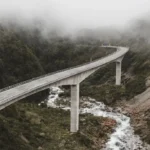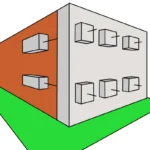What is Slope Stability?

Slope stability is a highly relevant concept in the field of geotechnics and civil engineering. It refers to the ability of an earth slope, whether a natural formation on a hill or an artificially created structure, to maintain its integrity, resisting collapse, sliding, or deformation. This notion is critically important in the planning, design, and construction of projects involving slopes, such as roads, dams, embankments, and retaining structures.
To assess the stability of a slope, engineers consider a set of interrelated factors. These factors range from the slope’s inclination to the type of soil or rock forming the slope, specific material properties, the load applied at the top of the slope, weather conditions, and the presence of water. The latter is particularly critical as it can significantly influence the slope’s ability to maintain integrity, acting as a trigger for landslides.
Stability analysis involves a thorough evaluation that aims to compare the forces affecting the slope (including gravity, applied load, water pressure, among others) with the inherent resistance of the soil or rock to deformation or displacement. The results of this analysis enable engineers to make crucial decisions about the need to implement stabilization measures. These measures may include constructing retaining walls, drainage systems, soil reinforcement, or even modifying the slope itself.
Importance of Slope Stability
In the realms of geotechnics and civil engineering, slope stability is a fundamental concept that plays a crucial role in safety, environmental preservation, and the viability of construction projects. But why is it so important? Let’s explore the reasons behind the significance of this topic:
Public Safety: Firstly, slope stability is a matter of public safety. The lack of stability in an earth slope, whether natural or constructed, can lead to landslides, collapses, or slides. These events can pose a significant danger to people living, working, or traveling near these slopes. Maintaining stability is essential to prevent accidents and protect human lives.
Infrastructure Protection: Unstable slopes can also have a significant impact on infrastructure. Damaging roads, bridges, railways, and nearby buildings is a real possibility in the case of slope instability. The costs associated with repairing and maintaining damaged infrastructure can be substantial.
Environmental Preservation: Slope instability can result in soil erosion and the deposition of sediments in nearby water bodies, causing environmental damage and affecting water quality. Environmental preservation is a fundamental goal in project planning.
Economy: Slope instability can also have a significant economic impact. It increases costs associated with emergency management, repairs, and maintenance of affected infrastructure, which can have a negative effect on the local and regional economy.
Project Planning: In the planning and design stage of construction projects, evaluating slope stability is essential. Lack of stability may require modifications to the project design and the implementation of additional stabilization measures, affecting the project’s cost and schedule.
Safety in Urban Environments: In urban areas, slope stability takes on an even more critical role due to the proximity of critical infrastructure and the presence of a large population. Slope stability in urban areas is essential to avoid disasters and ensure the safety of the population.
Sustainable Development: In a world that values sustainable development, slope stability becomes a key component of project planning and development. Mitigating negative impacts on the environment is a central goal.
Factors Influencing Slope Stability

In our journey towards a deeper understanding of slope stability, it is essential to explore the factors influencing this important geotechnical issue. These factors play a crucial role in assessing and maintaining safety on earth slopes. Here are the main factors you should be aware of:
Soil or Rock Type: One of the most influential factors is the type of material composing the slope. Different soil and rock types possess different geotechnical properties. Some soils, such as clay or silt, can retain water and become slippery, while solid rocks tend to be more stable. Material characteristics, such as cohesion and internal friction angle, are essential in determining slope resistance.
Slope Inclination: The slope or inclination of the slope is a critical factor. Steeper slopes tend to be less stable. Gravity has a greater effect on steep slopes, increasing the forces acting on the slope.
Applied Load: The load on top of the slope can influence its stability. Buildings, vehicles, or other elements exerting pressure on the slope can increase the load and the probability of instability.
Presence of Water: Water can have a significant impact on slope stability. Infiltration of water into the soil increases internal pressure and reduces cohesion, weakening the material and increasing the risk of sliding. Heavy rainfall and soil saturation are critical factors to consider.
Weather Conditions: Climate changes, such as temperature variations and heavy rains, can directly affect slope stability. Soil expansion and contraction due to temperature changes, as well as soil saturation from rainfall, can contribute to landslides.
Slope Geometry: The shape and geometry of the slope, including its height and width, can influence stability. Slopes with irregular shapes or variable inclinations may be more prone to instability.
Human Activities: Human activities, such as excavations, earth removal, or the construction of nearby infrastructure, can alter slope stability. Altering the slope geometry or introducing changes in applied load are examples of human factors that can affect stability.
Erosion: Soil erosion at the base of the slope or in its vicinity can weaken stability by reducing soil support and resistance capacity.
Vibrations and Seismic Activity: Vibrations caused by human activities or seismic events can affect slope stability by altering the balance of soil and rock.
Vegetation: The presence of vegetation can have both positive and negative impacts. On one hand, plant roots can stabilize the soil, but on the other hand, dense vegetation can retain water and increase pressure on the slope.
These factors are interconnected and must be evaluated together to determine slope stability and take appropriate measures to ensure safety. Geotechnics and geotechnical engineering are disciplines that deal with conducting these analyses and making informed decisions about slope stability.
Analysis and Stabilization Measures for Slopes

In the world of geotechnics and civil engineering, slope analysis and stabilization measures stand as fundamental pillars to maintain safety on earth slopes. When a risk of instability is detected on a slope, it is essential to carry out a meticulous process to prevent landslides and ensure stability. Here, we guide you through this process, designed to safeguard both the slope’s integrity and the safety of those around it.
Step 1: Site Assessment
Visual Inspection of the Slope: We begin with a visual inspection of the slope, looking for signs of instability such as cracks, deformations, slides, or erosion. This initial glance provides us with preliminary clues.
Soil or Rock Characterization: Next, we conduct a thorough geotechnical analysis to determine the properties of the soil or rock that makes up the slope. This stage involves evaluating cohesion, friction angle, permeability, and other relevant parameters.
Collection of Climatic Data: Additionally, we gather historical climatic data to understand how weather conditions can affect slope stability. Climate plays a significant role in this puzzle.
Step 2: Stability Analysis
Forces and Deformations Analysis: We perform exhaustive calculations to assess the forces acting on the slope, including gravity, applied load, and water pressure. We compare these forces with the resistance of the soil or rock.
Numerical Modeling: We use geotechnical modeling tools to simulate the slope’s behavior under various conditions. This allows us to anticipate possible landslides and assess their probability.
Factor of Safety Analysis: We calculate the factor of safety, which is the ratio between forces tending to destabilize the slope and those tending to keep it stable. A factor of safety below 1 suggests a risk of instability.
Step 3: Stabilization Measures
Construction of Retaining Walls: When dealing with unstable slopes, constructing retaining walls becomes an effective measure. These walls resist lateral pressure from the slope and prevent sliding.
Drainage Systems: Water control is crucial. Installing drainage systems, such as drainage ditches, channels, or pipes, helps reduce water pressure on the slope.
Soil Reinforcement: In some cases, slope stability can be improved by reinforcing the soil. This is achieved through techniques like soil compaction, grout injection, or the installation of geotextiles.
Modification of Slope: In specific situations, adjusting the slope’s inclination can make it more stable and secure.
Vegetation and Erosion: Planting vegetation on the slope can strengthen it by anchoring the soil with roots and reducing erosion.
Continuous Monitoring: To be vigilant for any signs of instability, geotechnical instruments, such as inclinometers and piezometers, are installed to monitor the slope over time.
Step 4: Emergency Planning
In areas where slope instability can affect communities, we develop emergency response plans. These plans include evacuation protocols and risk management.
This comprehensive process ensures a systematic approach to slope stability, combining assessment, analysis, and targeted measures to maintain safety and prevent potential disasters.







Related
What Is Soil Moisture?
What is Geodynamics? – the study of Earth’s changes
Tectonic Faults in Colombia and Their Impact on Civil Engineering